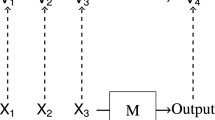Abstract
We present a theory of default reasoning that is specifically targeted to causal domains. These domains encompass a wide variety of current applications of default reasoning, but here we concentrate on model-based diagnosis. The theory is unique in that it integrates a formal notion of causality with nonmonotonic reasoning techniques based on default logic and abduction. The main structure of the theory is a default causal net (DCN) representing the causal connections among propositions in the domain. The causal net provides a framework for the two nonmonotonic reasoning techniques of assuming defaults and generating explanations for observations, allowing them to be combined in a principled way.
Similar content being viewed by others
References
P. Besnard and M.-O. Cordier, Explanatory diagnoses and their characterization by circumscription, this volume, Ann. Math. and AI 11 (1994) 75–96.
P.R. Cohen, J. Morgan and M.E. Pollack (eds.),Intentions in Communication (MIT Press, Cambridge, MA, 1990).
L. Console and P. Torasso, A spectrum of logical definitions of model-based diagnosis, Comput. Intelligence 7(3) (1991) 133–141.
L. Console, D. Theseider Dupre and P. Torasso, Abductive reasoning through direct deduction from completed domain models, in: Z. W. Ras (ed.),Methodologies for Intelligent Systems 4 (North-Holland, 1988) pp. 175–182.
R. Davis and W. Hamscher, Model-based reasoning: Troubleshooting, in: H. E. Shrobe (ed.),Exploring Artificial Intelligence: Survey Talks from the National Conferences on Artificial Intelligence (Morgan Kaufmann, San Mateo, CA, 12988) pp. 297–346.
J. de Kleer and B. C. Williams, Diagnosing multiple faults, Artificial Intelligence 32 (1987) 97–130.
J. de Kleer and B. C. Williams, Diagnosis with behavioral modes, in:Proc. Int. Joint Conf. on Artificial Intelligence, Detroit, MI, 1989.
J. de Kleer, A. Mackworth and R. Reiter, Characterizing diagnoses, in:Proc. Conf. of the American Association of Artificial Intelligence, Boston, MA, 1990.
J. de Kleer, An assumption-based truth maintenance system, Artificial Intelligence 28 (1986) 127–162.
O. Dressler and P. Struss, Back to defaults: Characterizing and computing diagnoses as coherent assumption sets,European Conference on Artificial Intelligence, Vienna, 1992.
G. Friedrich, G. Gotllob and W. Nejdl, Physical impossibility instead of fault models, in:Proc. Conf. of the American Association of Artificial Intelligence (MIT Press, 1990).
H. Geffner, Default reasoning: Causal and conditional theories, Ph.D. Thesis, Department of Computer Science, University of California at Los Angeles (1989).
U. Junker, Preferring diagnoses using a partial order on assumptions, this volume, Ann. Math. and AI 11 (1994) 169–185.
K. Konolige, What's happening: elements of commonsense causation, in:Proc. Int. Conf. on Cognitive Science, San Sebastian, Spain, May 1991.
K. Konolige, Abduction vs. closure in causal theories, Artificial Intelligence 53(2–3) (1992).
D. Lewis,Counterfactuals (Blackwell, 1973).
P. Pandurang Nayak, Causal approximation, in:Proc. Conf. of the American Association of Artificial Intelligence, Menlo Park, CA, 1992 (AAAI Press/MIT Press) pp. 703–709.
P. Pandurang Nayak, Order of magnitude reasoning using logarithms, in:Proc. Int. Conf. on Knowledge Representation and Reasoning, San Mateo, CA, 1992 (Morgan Kaufmann) pp. 201–210.
J. Pearl,Probabilistic Reasoning in Intelligent Systems: Networks of Plausible Inference (Morgan Kaufmann, San Mateo, CA, 1988).
D. Poole, Representing knowledge for logic-based diagnosis, in:Proc. Int. Conf. on Fifth Generation Computing Systems, Tokyo, 1988, pp. 1282–1290.
D. Poole, A methodology for using default and abductive reasoning system, Technical Report, Department of Computer Science, University of Waterloo, Waterloo, Ontario (1988).
D. Poole, Normality and faults in logic-based diagnosis, in:Proc. Int. Joint Conf. on Artificial Intelligence, Detroit, MI, 1989.
D. Poole, Representing diagnosis knowledge, this volume, Ann. Math. and AI 11 (1994) 33–50.
J. A. Reggia, D. S. Nau and Y. Wang, A formal model of diagnostic inference I. Problem formulation and decomposition, Inf. Sci. 37 (1985).
R. Reiter, A theory of diagnosis from first principles, Artificial Intelligence 32 (1987).
M. Shanahan, Prediction is deduction but explanation is abduction, in:Proc. Int. Joint Conf. on Artificial Intelligence, Detroit, MI, 1989.
Y. Shoham,Reasoning about Change: Time and Causation from the Standpoint of Artificial Intelligence (MIT Press, Cambridge, Massachusetts, 1987).
P. Strass and O. Dressler, Physical negation — integrating fault models into the general diagnostic engine, in:Proc. Int. Joint Conf. on Artificial Intelligence, Detroit, MI, 1989, pp. 1318–1323.
P. Suppes,A Probabilistic Theory of Causation (North-Holland, Amsterdam, 1970).
Author information
Authors and Affiliations
Rights and permissions
About this article
Cite this article
Konolige, K. Using default and causal reasoning in diagnosis. Ann Math Artif Intell 11, 97–135 (1994). https://doi.org/10.1007/BF01530739
Issue Date:
DOI: https://doi.org/10.1007/BF01530739




